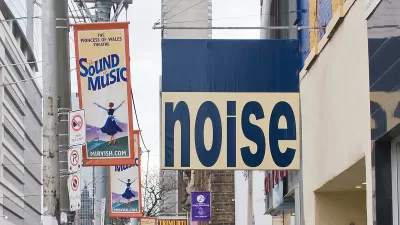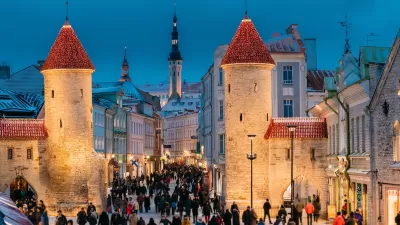Environmental noise can pose serious health risks ranging from sleep disruptions to higher blood pressure.

“In the world of occupational health, there’s long been awareness around the risk of noise-induced hearing loss, and today noise protection is a key part of workplace health and safety,” writes Emma Durand-Wood in a piece for Strong Towns.
But public health officials know less about “environmental noise,” the everyday sources of urban sound defined by the World Health Organization as “unwanted or harmful outdoor sound created by human activities, including noise from road, rail, airports and from industrial sites.”
More recently, research results have elevated noise pollution from a nuisance to a potentially severe health risk. “We now know that higher levels of environmental noise raise heart rate and blood pressure, cause harmful sleep interruptions, and are linked to cardiovascular disease, dementia, and cognitive impairment in children, among others.” In many U.S. cities, the racial and economic disparities that dictate where people live mean lower-income communities are often more exposed to excessive noise in addition to other harmful pollution.
Some urban noise is inevitable. But what can cities do to mitigate the damage and dampen unpleasant sounds? For one, they can plant more trees. “Adding trees or extra layers of vegetation alongside traditional noise barrier walls can significantly boost noise reduction.”
Durand-Wood also recommends permitting multifamily housing in more places—“Folks who prefer to or must live somewhere other than a single-family home shouldn’t be relegated to the noisiest areas, but in many places, multi-family housing is only being built along major corridors”—and reducing vehicle speeds and speed limits, which is shown to reduce the amount of associated road noise. Through relatively simple interventions, “Urban environments don’t need to be inherently noisy and harmful.”
FULL STORY: Why Are Cities So Noisy? And Can We Do Anything About It?

Alabama: Trump Terminates Settlements for Black Communities Harmed By Raw Sewage
Trump deemed the landmark civil rights agreement “illegal DEI and environmental justice policy.”

Study: Maui’s Plan to Convert Vacation Rentals to Long-Term Housing Could Cause Nearly $1 Billion Economic Loss
The plan would reduce visitor accommodation by 25% resulting in 1,900 jobs lost.

Why Should We Subsidize Public Transportation?
Many public transit agencies face financial stress due to rising costs, declining fare revenue, and declining subsidies. Transit advocates must provide a strong business case for increasing public transit funding.

Paris Bike Boom Leads to Steep Drop in Air Pollution
The French city’s air quality has improved dramatically in the past 20 years, coinciding with a growth in cycling.

Why Housing Costs More to Build in California Than in Texas
Hard costs like labor and materials combined with ‘soft’ costs such as permitting make building in the San Francisco Bay Area almost three times as costly as in Texas cities.

San Diego County Sees a Rise in Urban Coyotes
San Diego County experiences a rise in urban coyotes, as sightings become prevalent throughout its urban neighbourhoods and surrounding areas.
Urban Design for Planners 1: Software Tools
This six-course series explores essential urban design concepts using open source software and equips planners with the tools they need to participate fully in the urban design process.
Planning for Universal Design
Learn the tools for implementing Universal Design in planning regulations.
Smith Gee Studio
Alamo Area Metropolitan Planning Organization
City of Santa Clarita
Institute for Housing and Urban Development Studies (IHS)
City of Grandview
Harvard GSD Executive Education
Toledo-Lucas County Plan Commissions
Salt Lake City
NYU Wagner Graduate School of Public Service





























